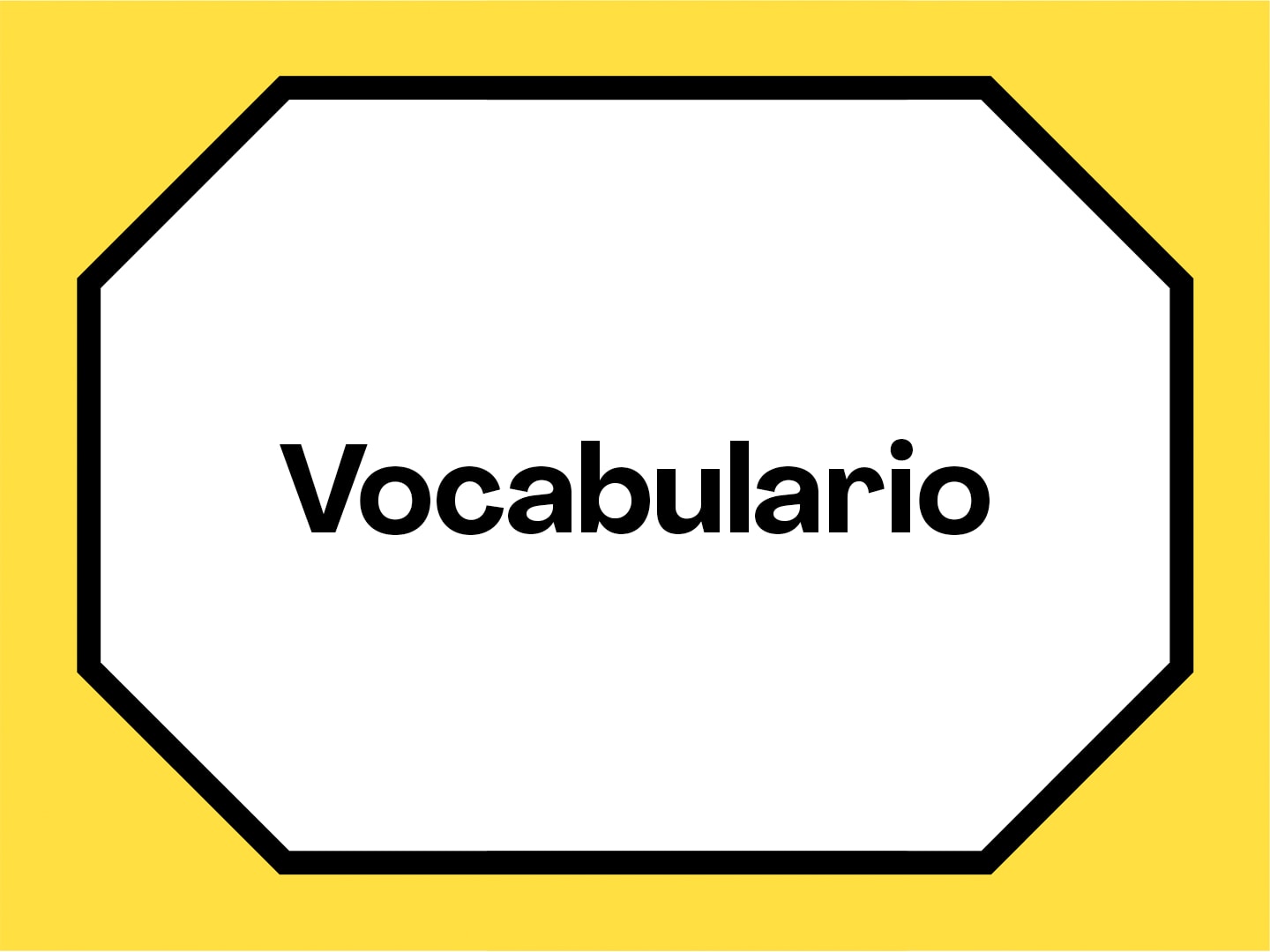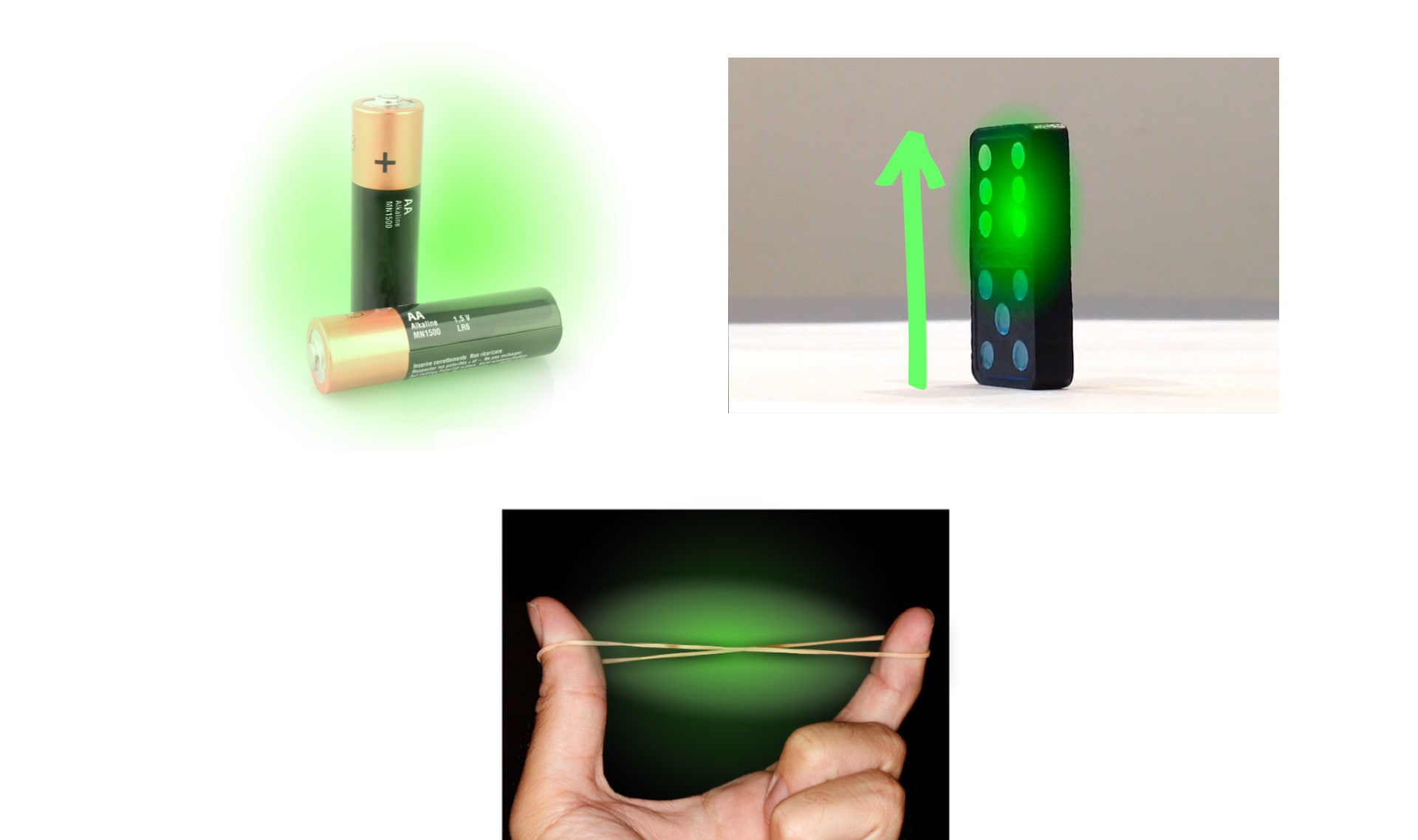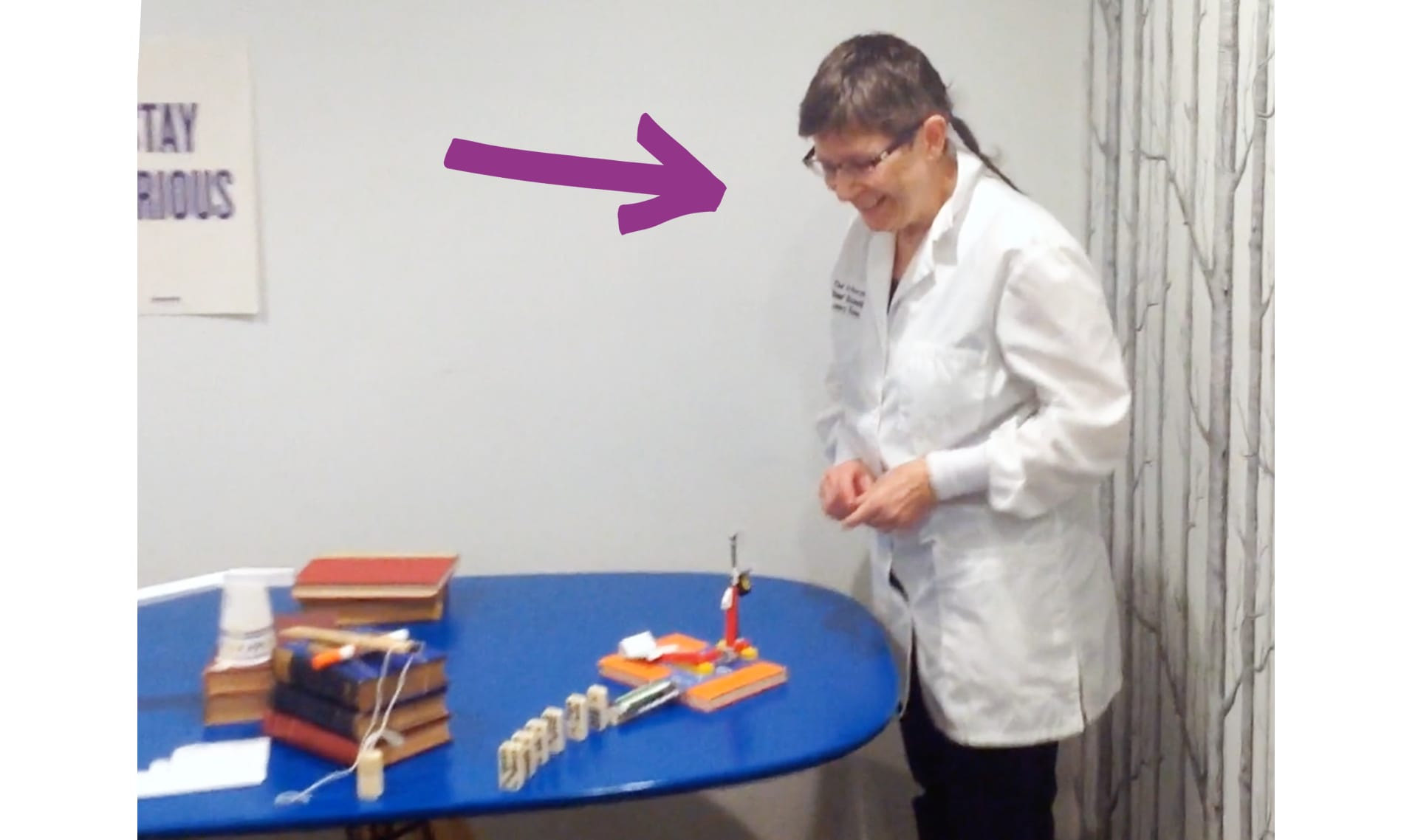
¿Puedes construir una máquina de reacción en cadena?
Energy Transfer & Engineering
4.6
(5007 reviews)
Scroll for prep

Please wait…
This video is having trouble loading. You may have lost your Internet connection.
Step 1: Click to Reload this page
Step 2: Click to
Try our other video player
Step 3: Contact your teacher if trouble persists.
Or,
dismiss this message.

Please wait…
This video is having trouble loading. You may have lost your Internet connection.
Step 1: Click to Reload this page
Step 2: Click to
Try our other video player
Step 3: Contact your teacher if trouble persists.
Or,
dismiss this message.
CONVERSEMOS (1 de 9): Al principio, Doug jala el palito. ¿De donde
obtuvo la energía para poder hacer eso?
obtuvo la energía para poder hacer eso?

Please wait…
This video is having trouble loading. You may have lost your Internet connection.
Step 1: Click to Reload this page
Step 2: Click to
Try our other video player
Step 3: Contact your teacher if trouble persists.
Or,
dismiss this message.
CONVERSEMOS (2 de 9): Sacar el palito hace que se caiga la llanta.
¿Hay energía almacenada en la llanta? ¿Si sí la hay, por qué?
¿Hay energía almacenada en la llanta? ¿Si sí la hay, por qué?

Please wait…
This video is having trouble loading. You may have lost your Internet connection.
Step 1: Click to Reload this page
Step 2: Click to
Try our other video player
Step 3: Contact your teacher if trouble persists.
Or,
dismiss this message.
CONVERSEMOS (3 de 9): La llanta se cae. ¿La energía se transfiere?
¿A donde se va?
¿A donde se va?

Please wait…
This video is having trouble loading. You may have lost your Internet connection.
Step 1: Click to Reload this page
Step 2: Click to
Try our other video player
Step 3: Contact your teacher if trouble persists.
Or,
dismiss this message.
CONVERSEMOS (4 de 9): La llanta le pega al martillo. ¿Hay energía
almacenada en el martillo? ¿Si sí la hay, por qué?
almacenada en el martillo? ¿Si sí la hay, por qué?

Please wait…
This video is having trouble loading. You may have lost your Internet connection.
Step 1: Click to Reload this page
Step 2: Click to
Try our other video player
Step 3: Contact your teacher if trouble persists.
Or,
dismiss this message.
CONVERSEMOS (5 de 9): El martillo se cae. ¿A qué le transfiere su
energía?
energía?

Please wait…
This video is having trouble loading. You may have lost your Internet connection.
Step 1: Click to Reload this page
Step 2: Click to
Try our other video player
Step 3: Contact your teacher if trouble persists.
Or,
dismiss this message.
CONVERSEMOS (6 de 9): El martillo le pega a la palanca. Un lado de
la palanca baja y el otro lado sube. ¿A qué le transfiere su energía?
la palanca baja y el otro lado sube. ¿A qué le transfiere su energía?

Please wait…
This video is having trouble loading. You may have lost your Internet connection.
Step 1: Click to Reload this page
Step 2: Click to
Try our other video player
Step 3: Contact your teacher if trouble persists.
Or,
dismiss this message.
CONVERSEMOS (7 de 9): El martillo también le pega a la canica.
¿Hay energía almacenada en la canica? ¿Si sí la hay, por qué?
¿Hay energía almacenada en la canica? ¿Si sí la hay, por qué?

Please wait…
This video is having trouble loading. You may have lost your Internet connection.
Step 1: Click to Reload this page
Step 2: Click to
Try our other video player
Step 3: Contact your teacher if trouble persists.
Or,
dismiss this message.
CONVERSEMOS (8 de 9): La canica atraviesa la rampa. ¿A qué le
transfiere su energía?
transfiere su energía?

Please wait…
This video is having trouble loading. You may have lost your Internet connection.
Step 1: Click to Reload this page
Step 2: Click to
Try our other video player
Step 3: Contact your teacher if trouble persists.
Or,
dismiss this message.
CONVERSEMOS (9 de 9): La canica le pega a la primera ficha de dominó.
¿Hay energía almacenada en las fichas de dominó? ¿Si sí la hay, por qué?
¿Hay energía almacenada en las fichas de dominó? ¿Si sí la hay, por qué?

Please wait…
This video is having trouble loading. You may have lost your Internet connection.
Step 1: Click to Reload this page
Step 2: Click to
Try our other video player
Step 3: Contact your teacher if trouble persists.
Or,
dismiss this message.

Please wait…
This video is having trouble loading. You may have lost your Internet connection.
Step 1: Click to Reload this page
Step 2: Click to
Try our other video player
Step 3: Contact your teacher if trouble persists.
Or,
dismiss this message.

Please wait…
This video is having trouble loading. You may have lost your Internet connection.
Step 1: Click to Reload this page
Step 2: Click to
Try our other video player
Step 3: Contact your teacher if trouble persists.
Or,
dismiss this message.
Paso
01/19
01/19
Si estás en una clase, busca un compañero o compañera con
quién trabajar.
quién trabajar.

Please wait…
This video is having trouble loading. You may have lost your Internet connection.
Step 1: Click to Reload this page
Step 2: Click to
Try our other video player
Step 3: Contact your teacher if trouble persists.
Or,
dismiss this message.
Paso
02/19
02/19
Obtén este primer grupo de materiales.
Cada grupo necesita estas cosas.
Cada grupo necesita estas cosas.

Please wait…
This video is having trouble loading. You may have lost your Internet connection.
Step 1: Click to Reload this page
Step 2: Click to
Try our other video player
Step 3: Contact your teacher if trouble persists.
Or,
dismiss this message.
Paso
03/19
03/19
Tú y tu compañero o compañera deben decidir quién será el
Doblador y quién será el Cortador.
Doblador y quién será el Cortador.

Please wait…
This video is having trouble loading. You may have lost your Internet connection.
Step 1: Click to Reload this page
Step 2: Click to
Try our other video player
Step 3: Contact your teacher if trouble persists.
Or,
dismiss this message.
Paso
04/19
04/19
Doblador: dobla la hoja de trabajo a mitad. Al terminar, debe de
quedar así.
quedar así.

Please wait…
This video is having trouble loading. You may have lost your Internet connection.
Step 1: Click to Reload this page
Step 2: Click to
Try our other video player
Step 3: Contact your teacher if trouble persists.
Or,
dismiss this message.
Paso
05/19
05/19
Cortador: corta a lo largo de las cuatro líneas punteadas.
Doblador: dobla las solapas de papel hacia arriba sobre las tres
líneas sólidas.
Doblador: dobla las solapas de papel hacia arriba sobre las tres
líneas sólidas.

Please wait…
This video is having trouble loading. You may have lost your Internet connection.
Step 1: Click to Reload this page
Step 2: Click to
Try our other video player
Step 3: Contact your teacher if trouble persists.
Or,
dismiss this message.
Paso
06/19
06/19
Cortador: voltea el papel y corta a lo largo de la línea punteada
para recortar el rectángulo rayado.
para recortar el rectángulo rayado.

Please wait…
This video is having trouble loading. You may have lost your Internet connection.
Step 1: Click to Reload this page
Step 2: Click to
Try our other video player
Step 3: Contact your teacher if trouble persists.
Or,
dismiss this message.
Paso
07/19
07/19
Doblador: dobla la solapa con el signo de interrogación. Remarca
el doblez con tu uña para que quede bien doblado.
el doblez con tu uña para que quede bien doblado.

Please wait…
This video is having trouble loading. You may have lost your Internet connection.
Step 1: Click to Reload this page
Step 2: Click to
Try our other video player
Step 3: Contact your teacher if trouble persists.
Or,
dismiss this message.
Paso
08/19
08/19
Con tu compañero o compañera, decide la frase clave o el mensaje
que quieren que aparezca al final de su máquina de reacción en
cadena.
que quieren que aparezca al final de su máquina de reacción en
cadena.

Please wait…
This video is having trouble loading. You may have lost your Internet connection.
Step 1: Click to Reload this page
Step 2: Click to
Try our other video player
Step 3: Contact your teacher if trouble persists.
Or,
dismiss this message.
Paso
09/19
09/19
Doblador: Escribe el mensaje sobre la solapa de abajo, de
esta manera.
esta manera.

Please wait…
This video is having trouble loading. You may have lost your Internet connection.
Step 1: Click to Reload this page
Step 2: Click to
Try our other video player
Step 3: Contact your teacher if trouble persists.
Or,
dismiss this message.
Paso
10/19
10/19
Cortador: Pega el vaso a la orilla de la mesa, de esta forma.
Asegúrate de que puedas moverlo hacia arriba.
Asegúrate de que puedas moverlo hacia arriba.

Please wait…
This video is having trouble loading. You may have lost your Internet connection.
Step 1: Click to Reload this page
Step 2: Click to
Try our other video player
Step 3: Contact your teacher if trouble persists.
Or,
dismiss this message.
Paso
11/19
11/19
Doblador: Sostén el papel para que las tres barras que dicen "mesa"
estén en la orilla de la mesa, de esta manera. Cortador: Pega las
solapas en su lugar, así.
estén en la orilla de la mesa, de esta manera. Cortador: Pega las
solapas en su lugar, así.

Please wait…
This video is having trouble loading. You may have lost your Internet connection.
Step 1: Click to Reload this page
Step 2: Click to
Try our other video player
Step 3: Contact your teacher if trouble persists.
Or,
dismiss this message.
Paso
12/19
12/19
Cortador: Levanta la parte de abajo del letrero, y Doblador: Añade
dos clips a la solapa que tiene el signo de interrogación.
dos clips a la solapa que tiene el signo de interrogación.

Please wait…
This video is having trouble loading. You may have lost your Internet connection.
Step 1: Click to Reload this page
Step 2: Click to
Try our other video player
Step 3: Contact your teacher if trouble persists.
Or,
dismiss this message.
Paso
13/19
13/19
Cortador: Inclina el vaso para que quede sobre el papel, así.
Doblador: Empuja ligeramente la parte de abajo del letrero.
Doblador: Empuja ligeramente la parte de abajo del letrero.

Please wait…
This video is having trouble loading. You may have lost your Internet connection.
Step 1: Click to Reload this page
Step 2: Click to
Try our other video player
Step 3: Contact your teacher if trouble persists.
Or,
dismiss this message.
Paso
14/19
14/19
Toma una canica y una de las rampas que hiciste la semana
pasada. Acomódala de manera que la rampa termine en el vaso.
pasada. Acomódala de manera que la rampa termine en el vaso.

Please wait…
This video is having trouble loading. You may have lost your Internet connection.
Step 1: Click to Reload this page
Step 2: Click to
Try our other video player
Step 3: Contact your teacher if trouble persists.
Or,
dismiss this message.
Paso
15/19
15/19
Tómate un minuto para probar tu letrero. Haz que tu canica baje
por la rampa y llegue al vaso.
por la rampa y llegue al vaso.

Please wait…
This video is having trouble loading. You may have lost your Internet connection.
Step 1: Click to Reload this page
Step 2: Click to
Try our other video player
Step 3: Contact your teacher if trouble persists.
Or,
dismiss this message.
Paso
16/19
16/19
Conversemos:

Please wait…
This video is having trouble loading. You may have lost your Internet connection.
Step 1: Click to Reload this page
Step 2: Click to
Try our other video player
Step 3: Contact your teacher if trouble persists.
Or,
dismiss this message.
Paso
17/19
17/19
Esto fue lo que se nos ocurrió a nosotros:

Please wait…
This video is having trouble loading. You may have lost your Internet connection.
Step 1: Click to Reload this page
Step 2: Click to
Try our other video player
Step 3: Contact your teacher if trouble persists.
Or,
dismiss this message.
Paso
18/19
18/19
Reescribe tu mensaje en una tarjetita index y métele entre las dos
solapas. Usa clips extras para mantener la solapa con el signo de
interrogación hacia abajo.
solapas. Usa clips extras para mantener la solapa con el signo de
interrogación hacia abajo.

Please wait…
This video is having trouble loading. You may have lost your Internet connection.
Step 1: Click to Reload this page
Step 2: Click to
Try our other video player
Step 3: Contact your teacher if trouble persists.
Or,
dismiss this message.
Paso
19/19
19/19
Añade por lo menos un paso más a tu máquina. Si tienes tiempo,
agrégale otros dos o tres pasos.
agrégale otros dos o tres pasos.


Please wait…
This video is having trouble loading. You may have lost your Internet connection.
Step 1: Click to Reload this page
Step 2: Click to
Try our other video player
Step 3: Contact your teacher if trouble persists.
Or,
dismiss this message.
energía
1 de 6
la habilidad de hacer una acción

energía almacenada
2 de 6
energía que no está siendo utilizada y que está guardada dentro de algo, por ejemplo, dentro de pilas o en ligas

Please wait…
This video is having trouble loading. You may have lost your Internet connection.
Step 1: Click to Reload this page
Step 2: Click to
Try our other video player
Step 3: Contact your teacher if trouble persists.
Or,
dismiss this message.
máquina de reacción en cadena
3 de 6
una máquina que usa una serie de transferencias de energía, por ejemplo, cuando usamos una ficha de dominó para tumbar toda una hilera de fichas de dominó

Please wait…
This video is having trouble loading. You may have lost your Internet connection.
Step 1: Click to Reload this page
Step 2: Click to
Try our other video player
Step 3: Contact your teacher if trouble persists.
Or,
dismiss this message.
transferencia de energía
4 de 6
cuando la energía fluye de un lugar a otro

experimento
5 de 6
una prueba que se usa para descubrir más información sobre una pregunta

ingeniera
6 de 6
una persona que utiliza la ciencia para diseñar soluciones a ciertos problemas


